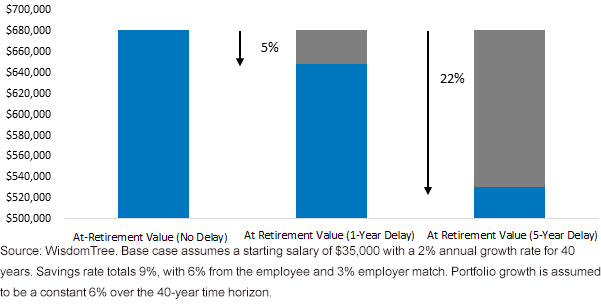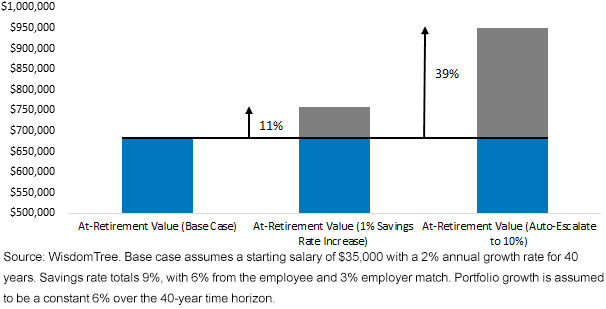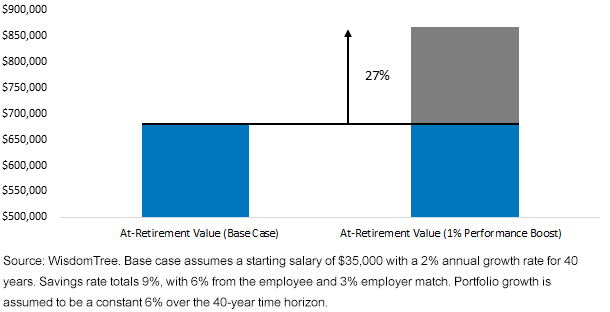3 Basic Tools to Improve Retirement Readiness


Over the past decade, the retirement industry and all involved have witnessed a tremendous amount of change, which was marked by the growing importance of defined contribution (DC) plans. The shift toward DC plans has not been without its critics, who doubt the ability of participants to achieve retirement readiness in this new world. While there is no silver bullet to achieving retirement readiness, nor is there a guarantee, there are ways plan sponsors can improve the probability of success for their participants. Simply stated, the probability of success is improved when people save more money, for a longer period of time, while invested in a diversified portfolio.
While these basic concepts are well known across the retirement industry and easy to grasp, plan participants often look past them as they focus on more immediate needs and desires early in their careers. Thankfully with the passage of the Pension Protection Act (PPA) in 2006, plan sponsors were afforded various safe harbors that automated meaningful improvements across these critical areas:
Basic automatic enrollment:(automatic contribution arrangement [ACA])
- Allows an employer to automatically deduct elective deferrals from an employee’s wages unless the employee makes an election not to contribute or to contribute a different amount
Qualified automatic contribution arrangement (QACA)
- Uniformly applies the plan’s default deferral percentage to all employees after giving them the required notice
Qualified default investment alternative (QDIA)
- An investment option that is appropriate as a single investment capable of meeting a worker’s long-term retirement savings needs and could include target date funds, management accounts or balanced funds
Over the long term, the above should work to significantly improve retirement readiness.
For example, if a participant delays saving by one year, the ending balance at retirement declines by ~5%, all else equal. If that delay stretches out to five years, the ending balance declines by more than 22%.
At Retirement Balance

Packing an even larger punch is the savings rate, in which a 1% increase over a 40-year working career can mean an 11% higher balance at retirement. Should the employee participate in auto-escalation, where the savings rate increases 1% per year from 6% to 10%, the ending balance increases a staggering 39%.
At-Retirement Balance

Of course, it isn’t enough to simply identify the impact that saving more for longer in a diversified portfolio can have. These tools must be utilized if participants are to reap their benefits. The good news is that in our conversations with plan sponsors, consultants and advisors, we are constantly told that these features have been widely adopted. More broadly, according to Callan’s 2017 Defined Contribution Trends Survey, roughly 65% of DC plans employ auto-enrollment, with one-third of plans not using auto-enrollment because their participation rate is already sufficient. Furthermore, auto-escalation has enjoyed rapid adoption in recent years, going from 35% in 2011 to 63% in 2016.
With respect to QDIAs, we’ve also witnessed significant adoption. According to Vanguard’s How America Saves 2016, eight in 10 plans have elected a QDIA. Why is this significant? Because, according to research, participants receiving some level of professional help versus the do-it-yourself participants enjoy a positive performance gap of more than 3%. Our work suggests that a performance gap of even 1% yields an at-retirement balance increase of more than 27%.
At-Retirement Balance

When considering actual participant data as provided by the Employee Benefit Research Institute, we can observe a clear difference in usage, with younger participants and those with shorter tenure making greater use of balanced funds (either target date or target risk funds). Couple that with the inertia that dominates DC plan participants and we have strong reason to believe that a significant number of participants will not suffer the performance gap of the do-it-yourself crowd in the future.
As you can see, there is much reason for optimism that tomorrow’s DC plan participants, ever more reliant on their defined contribution balances to fund their retirement, will invest better and save more for longer moving forward.
Of course, participants face many challenges in their quest to achieve retirement readiness, which will be the subject of a future post.


